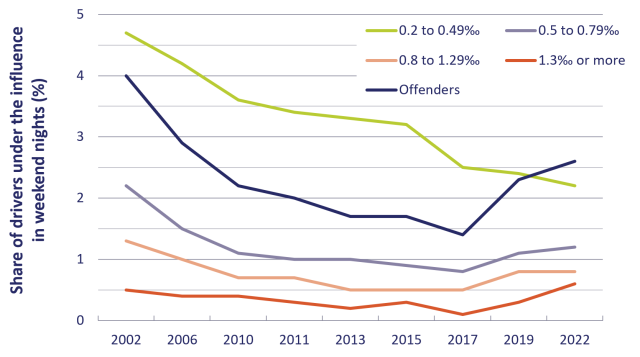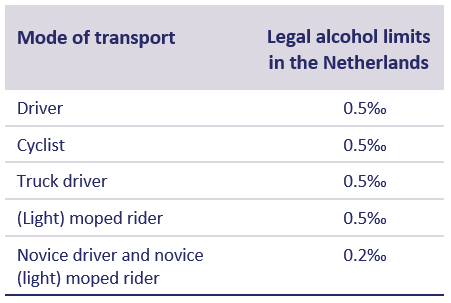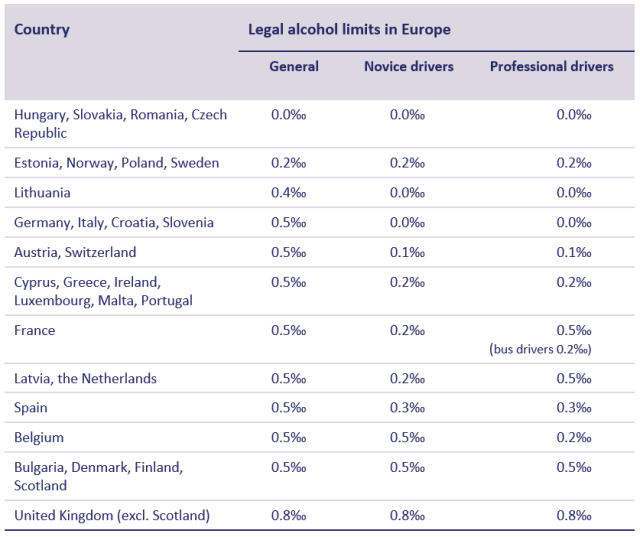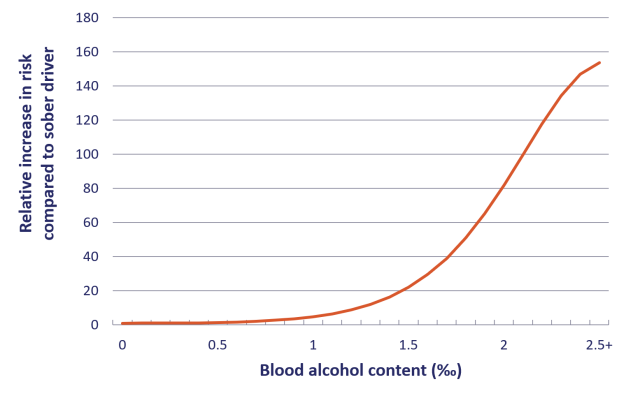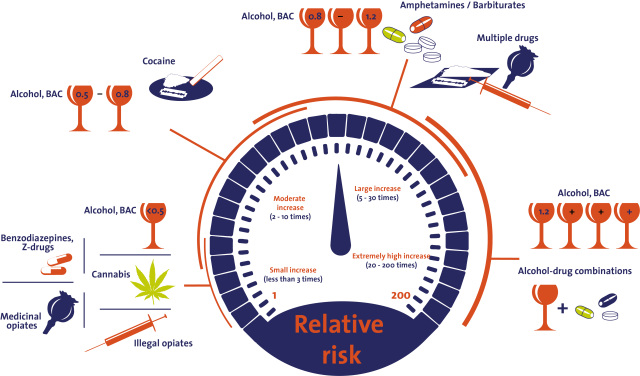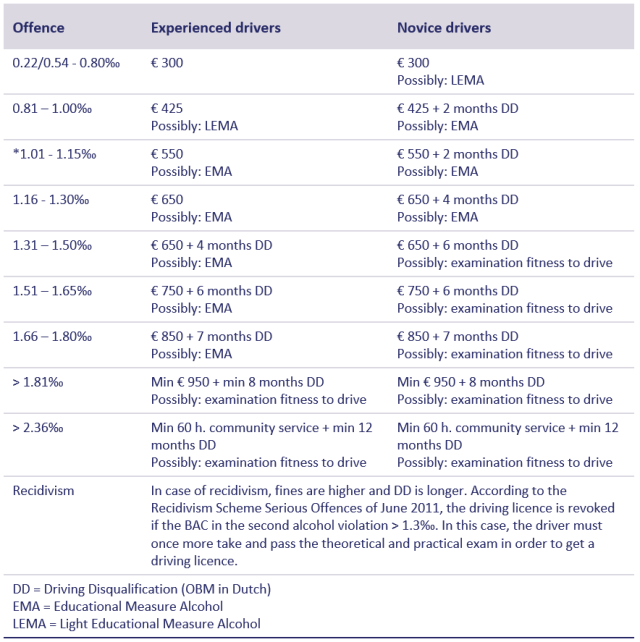Below you will find the list of references that are used in this fact sheet; all sources can be consulted or retrieved. Via Publicaties you can find more literature on the subject of road safety.
[1]. I&O Research (2022). Rijden onder invloed in Nederland in 2006-2022. Ontwikkeling van het alcoholgebruik van automobilisten in weekendnachten. Rapportnummer 266. Ministerie van Infrastructuur & Waterstaat. Rijkswaterstaat Water, Verkeer en Leefomgeving, ‘s-Gravenhage.
[2]. RTL Nieuws (2018). Drankrijder heeft vrij spel in Nederland: pakkans flink gedaald. Accessed on 07-04-2021 at www.rtlnieuws.nl/nieuws/nederland/artikel/4214801/drankrijder-heeft-vrij-spel-nederland-pakkans-flink-gedaald.
[3]. NOS (2017). Aantal alcoholcontroles afgelopen drie jaar gehalveerd. NOS. Accessed on 07-04-2021 at nos.nl/artikel/2156235-aantal-alcoholcontroles-afgelopen-drie-jaar-gehalveerd.html.
[4]. Goldenbeld, C. & Buttler, I. (2019). Enforcement and traffic violations v. ESRA2 Thematic report Nr. 6 - E-Survey of Road users’ Attitudes. SWOV, Den Haag.
[5]. Scholten, K. & Lemmers, L. (2020). Verkenning van de preventiemogelijkheden van rijden onder invloed. Discussienotitie. Trimbos-instituut, Utrecht.
[6]. AD (2020). Politie controleert minder op de weg vanwege corona, alcoholcontroles opgeschort. Webartikel 20-03-20. Accessed on 15-11-2022 at www.ad.nl/auto/politie-controleert-minder-op-de-weg-vanwege-corona-alcoholcontroles-opgeschort~ae8911ae/.
[7]. Houwing, S., Twisk, D.A.M. & Waard, D. de (2015). Alcoholgebruik van jongeren in het verkeer op stapavonden. R-2015-12. SWOV, Den Haag.
[8]. Overheid.nl (2020). Richtlijn voor strafvordering rijden onder invloed van alcohol en/of drugs en rijden tijdens een rijverbod. Overheid.nl. Wettenbank. Accessed on 13-12-2022 at wetten.overheid.nl/BWBR0042986/2020-01-01.
[9]. ETSC (2021). Blood Alcohol Content (BAC) Drink Driving Limits across Europe. European Transport Safety Council. Accessed on 30-11-2022 at etsc.eu/issues/drink-driving/blood-alcohol-content-bac-drink-driving-limits-across-europe/.
[10]. Ogden, E.J.D. & Moskowitz, H. (2004). Effects of alcohol and other drugs on driver performance. In: Traffic Injury Prevention, vol. 5, nr. 3, p. 185-198.
[11]. EC (2021). Road safety thematic report – Alcohol, drugs and medicine. European Road Safety Observatory. European Commission, Directorate General for Transport, Brussels.
[12]. Moskowitz, H. & Fiorentino, D. (2000). A review of the literature on the effects of low doses of alcohol on driving-related skills. Department of Transportation DOT, National Highway Traffic Safety Administration NHTSA, Washington, D.C.
[13]. Caird, J.K., Lees, M. & Edwards, C.J. (2005). The naturalistic driver model: A review of distraction, impairment and emergency factors. University of California, Institute of Transportation Studies ITS, Berkeley, CA.
[14]. Dupont, E., Martensen, H. & Silverans, P. (2010). Verlaagde alcohollimiet voor onervaren bestuurders en voor bestuurders van grote voertuigen: 0,2. Belgisch Instituut voor de Verkeersveiligheid BIVV, Observatorium voor de Verkeersveiligheid, Brussel.
[15]. Irwin, C., Iudakhina, E., Desbrow, B. & McCartney, D. (2017). Effects of acute alcohol consumption on measures of simulated driving: A systematic review and meta-analysis. In: Accident Analysis & Prevention, vol. 102, p. 248-266.
[16]. Minister JenV (2019). Wettelijke mogelijkheden standaard bloedonderzoek bij verkeersongevallen. 33628-43. Government document dd. 14 maart 2019. F.B.J. Grapperhaus, minister van Justitie en Veiligheid, Den Haag.
[17]. Valkenberg, H. & Nijman, S. (2022). Middelengebruik in het verkeer. Een analyse van data verzameld op SEH-afdelingen. Rapport 947. VeiligheidNL, Amsterdam.
[18]. SWOV (2016). In 2015 75 tot 140 verkeersdoden als gevolg van alcohol. SWOV. Accessed on 28-05-2021 at www.swov.nl/nieuws/2015-75-tot-140-verkeersdoden-als-gevolg-van-alcohol.
[19]. Houwing, S., Bijleveld, F.D., Commandeur, J.J.F. & Vissers, L. (2014). Het werkelijk aandeel verkeersdoden als gevolg van alcohol. Aanpassing schattingsmethodiek [The actual proportion of road fatalities due to alcohol. Update of the estimation method]. R-2014-32.[Summary in English] SWOV, Den Haag.
[20]. Blomberg, R.D., Peck, R.C., Moskowitz, H., Burns, M., et al. (2005). Crash risk of alcohol involved driving: A case-control study. Contract Number DTNH22-94-C-05001 Dunlap and Associates, Inc., Stamford, CT.
[21]. Compton, R.P. & Berning, A. (2015). Drug and alcohol crash risk. Traffic Safety Facts Research Note. DOT HS 812 117. National Highway Traffic Safety Administration NHTSA, Washington.
[22]. Peck, R.C., Gebers, M.A., Voas, R.B. & Romano, E. (2008). The relationship between blood alcohol concentration (BAC), age, and crash risk. In: Journal of Safety Research, vol. 39, nr. 3, p. 311-319.
[23]. Asbridge, M., Mann, R., Cusimano, M.D., Tallon, J.M., et al. (2014). Cycling-related crash risk and the role of cannabis and alcohol: a case-crossover study. In: Preventive Medicine, vol. 66, p. 80-86.
[24]. Hels, T., Bernhoft, I.M., Lyckegaard, A., Houwing, S., et al. (2011). Risk of injury by driving with alcohol and other drugs. Deliverable D2.3.5 of the EU FP6 project DRUID. European Commission, Brussels.
[25]. I&O Research (2021). Rijden onder invloed in Nederland in 2006-2019. Ontwikkeling van het alcoholgebruik van automobilisten in weekendnachten. Ministerie van Infrastructuur & Waterstaat IenW; Rijkswaterstaat Water, Verkeer en Leefomgeving WVL, ‘s-Gravenhage.
[26]. Mathijssen, R. & Houwing, S. (2005). The prevalence and relative risk of drink and drug driving in the Netherlands: a case-control study in the Tilburg police district. Research in the framework of the European research programme IMMORTAL. R-2005-9. SWOV, Leidschendam.
[27]. Keall, M.D., Frith, W.J. & Patterson, T.L. (2004). The influence of alcohol, age and number of passengers on the night-time risk of driver fatal injury in New Zealand. In: Accident Analysis & Prevention, vol. 36, nr. 1, p. 49-61.
[28]. Isalberti, C., Linden, T. van der, Legrand, S.-A., Verstraete, A., et al. (2011). Prevalence of alcohol and other psychoactive substances in injured and killed drivers. Deliverable D2.2.5 of the EU FP6 project DRUID. European Commission, Brussels.
[29]. Goldenbeld, C., Blom, M. & Houwing, S. (2016). Zware alcoholovertreders in het verkeer. Omvang van het probleem en kenmerken van de overtreders [Serious alcohol offenders in traffic. Extent of the problem and characteristics of the offenders]. R-2016-12. [Summary in English] SWOV, Den Haag.
[30]. OM (2022). Recidiveregeling alcohol en drugs. Openbaar Ministerie. Accessed on 01-12-2022 at www.om.nl/onderwerpen/verkeer/handhaving/alcohol/recidiveregeling-alcohol-en-drugs.
[31]. Blom, M. & Weijters, G. (2020). Recidive na het CBR onderzoek alcohol. Cahier 2020-22. Wetenschappelijk Onderzoek Documentatie Centrum WODC, Den Haag.
[32]. Trimbos Instituut (2018). Wat zijn de boetes en straffen voor rijden onder invloed van alcohol? Accessed on 07-12-2022 at www.alcoholinfo.nl/verkeer/boetes-straffen-rijden-onder-invloed.
[33]. Blom, M., Blokdijk, D. & Weijters, G. (2019). Recidive na maatregelen rijvaardigheid en geschiktheid. Cahier 2019-20. Wetenschappelijk Onderzoek- en Documentatiecentrum WODC, Den Haag.
[34]. Blom, M. & Blokdijk, D. (2021). Long-term effectiveness of the alcohol ignition interlock programme: A retrospective cohort study in the Netherlands. In: Accident Analysis & Prevention, vol. 151, p. 105888.
[35]. Bax, C., Kärki, O., Evers, C., Bernhoft, I.M., et al. (2001). Alcohol interlock implementation in the European Union; Feasibility study. Final report of the European research project. D-2001-20. SWOV, Leidschendam.
[36]. Elder, R.W., Voas, R., Beirness, D., Shults, R.A., et al. (2011). Effectiveness of Ignition Interlocks for Preventing Alcohol-Impaired Driving and Alcohol-Related Crashes: A Community Guide Systematic Review. In: American Journal of Preventive Medicine, vol. 40, nr. 3, p. 362-376.
[37]. Nochajski, T.H., Manning, A.R., Voas, R., Taylor, E.P., et al. (2020). The impact of interlock installation on driving behavior and drinking behavior related to driving. In: Traffic Injury Prevention, vol. 21, nr. 7, p. 419-424.
[38]. Nieuwkamp, R., Martensen, H. & Meesmann, U. (2017). Alcohol interlock. European Road Safety Decision Support System, developed by the H2020 project SafetyCube. Accessed on 01-03-2018 at www.roadsafety-dss.eu.
[39]. Assailly, J.P. & Cestac, J. (2014). Alcohol interlocks and prevention of drunk-driving recidivism. In: Revue Européenne de Psychologie Appliquée/European Review of Applied Psychology, vol. 64, nr. 3, p. 141-149.
[40]. Ma, T., Byrne, P.A., Bhatti, J.A. & Elzohairy, Y. (2016). Program design for incentivizing ignition interlock installation for alcohol-impaired drivers: The Ontario approach. In: Accident Analysis & Prevention, vol. 95, p. 27-32.
[41]. Voas, R.B., Tippetts, A.S. & Grosz, M. (2013). Administrative Reinstatement Interlock Programs: Florida, A 10‐Year Study. In: Alcoholism: Clinical and Experimental Research, vol. 37, nr. 7, p. 1243-1251.
[42]. Bjerre, B. & Thorsson, U. (2008). Is an alcohol ignition interlock programme a useful tool for changing the alcohol and driving habits of drink-drivers? In: Accident Analysis & Prevention, vol. 40, nr. 1, p. 267-273.
[43]. Gustafsson, S. & Forsman, A. (2016). Utvärdering av alkolås efter rattfylleri: enkätstudie [Evaluation of a Swedish alcohol interlock program for drink driving offenders: questionnaire study]. VTI-code: 35-2016 [Summary in English]. VTI, Linköping.
[44]. Voas, R.B., Tippetts, A.S., Bergen, G., Grosz, M., et al. (2016). Mandating treatment based on interlock performance: Evidence for effectiveness. In: Alcoholism: Clinical and Experimental Research, vol. 40, nr. 9, p. 1953-1960.
[45]. Ullman, D.F. (2016). Locked and not loaded: First time offenders and state ignition interlock programs. In: International Review of Law and Economics, vol. 45, p. 1-13.
[46]. Kaufman, E.J. & Wiebe, D.J. (2016). Impact of state ignition interlock laws on alcohol-involved crash deaths in the United States. In: American Journal of Public Health, vol. 106, nr. 5, p. 865-871.
[47]. McGinty, E.E., Tung, G., Shulman-Laniel, J., Hardy, R., et al. (2017). Ignition interlock laws: Effects on fatal motor vehicle crashes, 1982–2013. In: American Journal of Preventive Medicine, vol. 52, nr. 4, p. 417-423.
[48]. Teoh, E.R., Fell, J.C., Scherer, M. & Wolfe, D.E.R. (2018). State alcohol ignition interlock laws and fatal crashes. Insurance Institute for Highway Safety, Arlington, Virginia.
[49]. Goldenbeld, C., Houwing, S., Wijnen, W., Decae, R., et al. (2020). Cost benefit analysis of the Irish alcohol interlock program. R-2020-31. SWOV, The Hague.
[50]. Minister van JenV (2018). Aanpak rijden onder invloed van alcohol. 29398-588. Government document dd. 7 maart 2018. F.B.J. Grapperhaus, minister van Justitie en Veiligheid en C. van Nieuwenhuizen Wijbenga, minister van Infrastructuur en Waterstaat.
[51]. Blom, M., Boschman, S.E. & Weijters, G. (2022). Differentiële effectiviteit maatregelen alcohol en verkeer. Cahier 2022-7. Wetenschappelijk Onderzoek- en documentatie Centrum WODC, Den Haag.
[52]. Blom, M., Blokdijk, D. & Weijters, G. (2017). Recidive na een educatieve maatregel voor verkeersovertreders of tijdens een Alcoholslotprogramma. Cahier 2017-15. Wetenschappelijk Onderzoek- en Documentatiecentrum WODC, Den Haag.
[53]. I&O Research (2018). Rijden onder invloed in Nederland in 2002-2017: ontwikkeling van het alcoholgebruik van automobilisten in weekendnachten. Ministerie van Infrastructuur en Waterstaat, Water, Verkeer en Leefomgeving WVL, ‘s-Gravenhage.
[54]. Weijermars, W.A.M. & Schagen, I.N.L.G. van (2009). Tien jaar Duurzaam Veilig. Verkeersveiligheidsbalans 1998-2007 [Ten years of Sustainable Safety. Road safety assessment 1998-2007]. R-2009-14. [Summary in English] SWOV, Leidschendam.
[55]. Zwerling, C. & Jones, M.P. (1999). Evaluation of the effectiveness of low blood alcohol concentration laws for younger drivers. In: American Journal of Preventive Medicine, vol. 16, nr. 1, Supplement 1, p. 76-80.
[56]. Shults, R.A., Elder, R.W., Sleet, D.A., Nichols, J.L., et al. (2001). Reviews of evidence regarding interventions to reduce alcohol-impaired driving. In: American Journal of Preventive Medicine, vol. 21, nr. 4, Supplement 1, p. 66-88.
[57]. Romano, E., Scherer, M., Fell, J. & Taylor, E. (2015). A comprehensive examination of U.S. laws enacted to reduce alcohol-related crashes among underage drivers. In: Journal of Safety Research, vol. 55, p. 213-221.
[58]. Macaluso, G., Theofilatos, A., Botteghi, G. & Ziakopoulos, A. (2017). Lowering BAC limits & BAC limits for specific groups (novice). European Road Safety Decision Support System, developed by the H2020 project SafetyCube. Accessed on 01-03-2018 at www.roadsafety-dss.eu.
[59]. Cammaert, M. & Woudstra, M. (2021). Campagne-effectonderzoek BOB 2020. DVJ Insights in opdracht van het ministerie van Infrastructuur en Waterstaat.
[60]. Rijksoverheid (2021). Wie is Bob en waar staat Bob voor? Ministerie van Infrastructuur en Waterstaat. Accessed on 27-05-2021 at www.rijksoverheid.nl/onderwerpen/verkeersveiligheid/vraag-en-antwoord/wie-is-bob-en-waar-staat-bob-voor.
[61]. WHO (2009). Evidence for the effectiveness and cost-effectiveness of interventions to reduce alcohol-related harm. World Health Organization Regional Office for Europe, Copenhagen.
[62]. Fell, J.C., Scolese, J., Achoki, T., Burks, C., et al. (2020). The effectiveness of alternative transportation programs in reducing impaired driving: A literature review and synthesis. In: Journal of Safety Research, vol. 75, p. 128-139.
[63]. Mathijssen, R. (2006). Rijden onder invloed. Wetenschappelijk Onderzoek- en Documentatiecentrum WODC, Den Haag.
[64]. Mathijssen, M.P.M. (1994). Rijden onder invloed in Nederland, 1992-1993. Ontwikkeling van het alcoholgebruik van automobilisten in weekendnachten [Driving under the influence in the Netherlands, 1992-1993. Development of car drivers' alcohol consumtion in weekend nights]. R-94-21. [Summary in English] SWOV, Leidschendam.
[65]. Moffatt, S. & Poynton, S. (2007). The deterrent effect of higher fines on recidivism: Driving offences. In: Crime and Justice Bulletin 2007, vol. 106.
[66]. Sloan, F.A., McCutchan, S.A. & Eldred, L.M. (2017). Alcohol-impaired driving and perceived risks of legal consequences. In: Alcoholism: Clinical and Experimental Research, vol. 41, nr. 2, p. 432-442.
[67]. Stringer, R.J. (2021). Drunk driving and deterrence: exploring the reconceptualized deterrence hypothesis and self-reported drunk driving. In: Journal of Crime and Justice, vol. 44, nr. 3, p. 316-331.
[68]. García-Echalar, A. & Rau, T. (2020). The effects of increasing penalties in drunk driving laws - Evidence from Chile. In: International journal of environmental research and public health, vol. 17, nr. 21, p. 8103.
[69]. Wagenaar, A.C., Maldonado-Molina, M.M., Erickson, D.J., Ma, L., et al. (2007). General deterrence effects of U.S. statutory DUI fine and jail penalties: Long-term follow-up in 32 states. In: Accident Analysis & Prevention, vol. 39, nr. 5, p. 982-994.
[70]. Rahman, S. & Weatherburn, D. (2020). Does prison deter drunk-drivers? In: Journal of Quantitative Criminology.
[71]. Howard, E., Harris, A. & McIntyre, A. (2020). Effectiveness of drink driving counter measures: National policy framework. Austroads, Sydney.
[72]. Goldenbeld, C. (2017). Licence suspension. European Road Safety Decision Support System, developed by the H2020 project SafetyCube. Accessed on 19-04-2021 at www.roadsafety-dss.eu.
[73]. Raml, R. (2017). Ein innovativer zugang in der Marktforschung: die Beleuchtung des Dunkelfelds. Fachtagung Verkehr & Mobilität, 12.01.2017. KvF, IFES, Wenen.
[74]. Vis, M.A., Goldenbeld, C. & Bruggen, B. van (2010). Rijden zonder geldig rijbewijs in Nederland. Hoe vaak komt het voor en wat betekent het voor de verkeersveiligheid? [Driving without a valid licence in the Netherlands. How frequent is it and what does it mean for road safety?] R-2010-13. [Summary in English] SWOV, Leidschendam.
[75]. Erke, A., Goldenbeld, C. & Vaa, T. (2009). The effects of drink-driving checkpoints on crashes—A meta-analysis. In: Accident Analysis & Prevention, vol. 41, nr. 5, p. 914-923.
[76]. Minister van VenJ (2017). Antwoorden op Kamervragen over het aantal alcoholcontroles in het verkeer. Government document. Ministerie van Justitie en Veiligheid, Den Haag.
[77]. Morrison, C.N., Kwizera, M., Chen, Q., Puljevic, C., et al. (2021). Alcohol-involved motor vehicle crashes and the size and duration of random breath testing checkpoints. In: Alcoholism: Clinical and Experimental Research, vol. 45, nr. 4, p. 784-792.
[78]. Calinescu, T. & Adminaite, D. (2018). Progress in Reducing Drink Driving in Europe. European Transport Safety Council, Brussels.
[79]. Andreuccetti, G., Carvalho, H.B., Cherpitel, C.J., Ye, Y., et al. (2011). Reducing the legal blood alcohol concentration limit for driving in developing countries: a time for change? Results and implications derived from a time–series analysis (2001–10) conducted in Brazil. In: Addiction, vol. 106, nr. 12, p. 2124-2131.
[80]. Campos, V.R., De Souza e Silva, R., Duailibi, S., Dos Santos, J.F., et al. (2013). The effect of the new traffic law on drinking and driving in São Paulo, Brazil. In: Accident Analysis & Prevention, vol. 50, p. 622-627.
[81]. Nistal-Nuño, B. (2017). Impact of a new law to reduce the legal Blood Alcohol Concentration limit - A Poisson Regression Analysis and Descriptive Approach. In: Journal of research in health sciences, vol. 17, nr. 1, p. e00374.
[82]. Otero, S. & Rau, T. (2017). The effects of drinking and driving laws on car crashes, injuries, and deaths: Evidence from Chile. In: Accident Analysis & Prevention, vol. 106, p. 262-274.
[83]. Desapriya, E., Pike, I., Subzwari, S., Scime, G., et al. (2007). Impact of lowering the legal blood alcohol concentration limit to 0.03 on male, female and teenage drivers involved alcohol-related crashes in Japan. In: International Journal of Injury Control and Safety Promotion, vol. 14, nr. 3, p. 181-187.
[84]. Davenport, S., Robbins, M., Cerdá, M., Rivera-Aguirre, A., et al. (2020). Assessment of the impact of implementation of a zero blood alcohol concentration law in Uruguay on moderate/severe injury and fatal crashes: a quasi-experimental study. In: Addiction.
[85]. Huang, C.Y., Chou, S.E., Su, W.T., Liu, H.T., et al. (2020). Effect of Lowering the Blood Alcohol Concentration Limit to 0.03 Among Hospitalized Trauma Patients in Southern Taiwan: A Cross-Sectional Analysis. In: Risk Manag Healthc Policy, vol. 13, p. 571-581.
[86]. Borschos, B.l. (2000). An evaluation of the Swedish drunken driving legislation implemented on February 1, 1994. In: Proceedings of the International Conference on Alcohol, Drugs and Traffic Safety (ICADTS). May 22-26, Stockholm.
[87]. Moreau, N., Martensen, H. & Daniels, S. (2022). Lowering the legal alcohol limit in Belgium. Potential effects on the number of traffic victims. In: Accident Analysis & Prevention, vol. 166, p. 106542.
[88]. Berghe, W. van den, Schachner, M., Sgarra, V. & Christie, N. (2020). The association between national culture, road safety performance and support for policy measures. In: IATSS Research, vol. 44, nr. 3, p. 197-211.
[89]. Carson, J., Jost, G. & Meinero, M. (2022). How traffic law enforcement can contribute to safer roads. PIN Flash report 42. European Transport Safety Council, ETSC, Brussels.
[90]. Foxcroft, D.R. & Tsertsvadze, A. (2011). Universal school-based prevention programs for alcohol misuse in young people. In: The Cochrane database of systematic reviews.
[91]. Doncker, J. de, Donder, E. de & Möbius, D. (2015). Dossier alcohol. VAD, Vlaams expertisecentrum Alcohol en andere Drugs, Brussel.
[92]. Scott-Sheldon, L.A., Carey, K.B., Elliott, J.C., Garey, L., et al. (2014). Efficacy of alcohol interventions for first-year college students: a meta-analytic review of randomized controlled trials. In: Journal of consulting and clinical psychology, vol. 82, nr. 2, p. 177-188.
[93]. Tison, J., Nichols, J.L., Casanova, T. & Chaudhary, N.K. (2015). Comparative study and evaluation of SCRAM use, recidivism rates, and characteristics. DOT HS 812 143. Department of Transportation DOT, National Highway Traffic Safety Administration NHTSA, Washington, D.C.
[94]. Minister JenV (2020). Evaluatie tweede pilotjaar Alcoholmeter. Government document 18 mei 2020. Ferd Grapperhaus, minister van Justitie en Veiligheid, Den Haag.
[95]. Burton, R., Henn, C., Lavoie, D., O'Connor, R., et al. (2017). A rapid evidence review of the effectiveness and cost-effectiveness of alcohol control policies: an English perspective. In: The Lancet, vol. 389, nr. 10078, p. 1558-1580.

